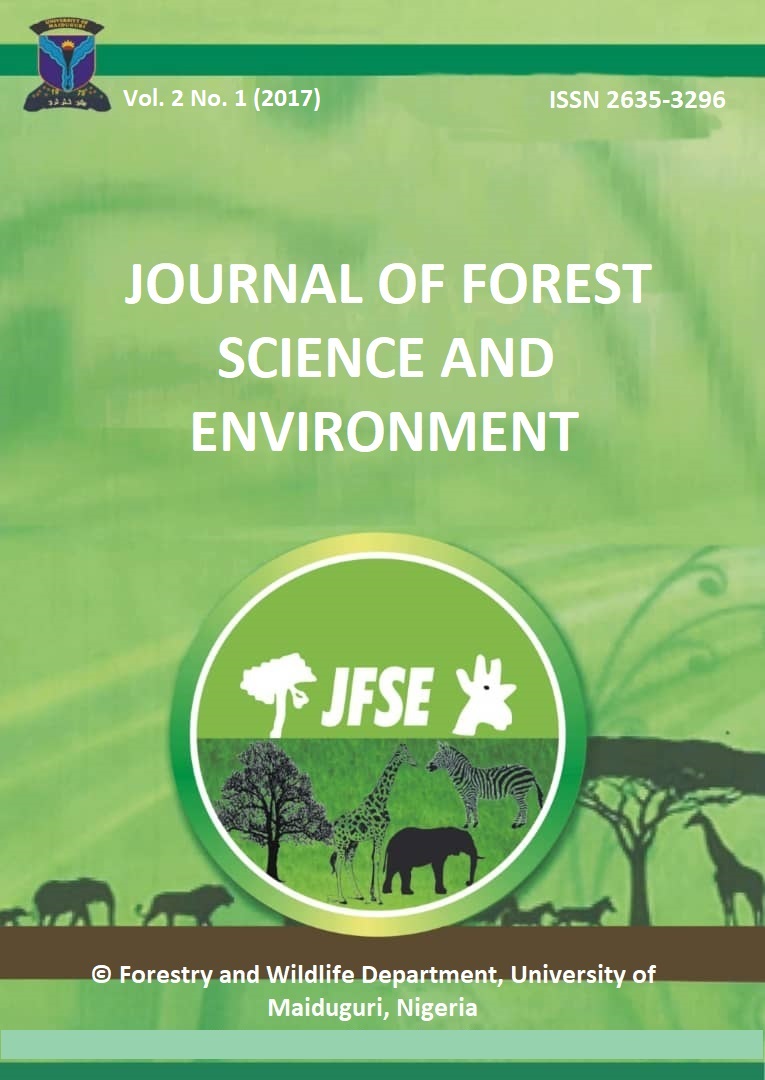Abstract
Sustainable management of plantations can increase carbon sequestration potentials and contribute to climate change mitigation. However, carbon stock estimates are scarce in most tropical forests. This study estimated above- and belowground biomass and developed biomass equations for stock estimation in three age series of Tectona grandis, using an inventory approach. Sample plots (20m x 20m) were laid in 5-, 10-, and 15-year old Tectona grandis plantations. All the trees within the plots were enumerated for total height and diameter at breast height (DBH). The DBH of two trees in each age series of Teak stand that was closest to the mean DBH were selected for destructive sampling to estimate the biomass. Thus, samples of roots, leaves as well as stem discs were collected at the base, DBH, middle point and merchantable height and were oven-dried to determine the moisture content and dry weight. Inventory and biomass data were analysed using descriptive and inferential statistics at p< 0.05 level of significance. The biomass equations were also developed using regression analysis. The growth variables increased with age, with mean DBH of 4.43cm, 18.02cm and 21.12cm for the 5, 10 and 15 year-old stands, respectively. Similarly, the mean heights were 4.02m, 15.99m and 17.57m. Carbon stocks increased in the 5, 10 and 15-year-old stands with 81.18C/ha, 476.58C/ha and 864.88C/ha estimated respectively. The models: LogB = -3.805 + 2.618LogDBH; and LogB = -34.009 + 2.316LogDBH gave the best fits for the 5 and 15-year-old stands, while LogB = -2.410 + 0.481LogDBH + 2.185LogH gave the best fit for the 10-year-old stand. Hence, DBHand height parameters are suitable variables for developing allometric equations and predicting biomass of Tectona grandis in plantations.
References
Aghimien EV, Osho JSA, Hauser S and Ade-Oni VD (2015). Forest Volume-to-Above-Ground Tree Biomass Models for the Secondary Forest in IITA, Ibadan, Nigeria. International Journal of Forest Research, 2015, 4 (3):1000152.
Akinyemi OD (1998). Ecological Studies on a Dry Lowland Rainforest: case study of Onigambari Forest Reserve- A Dissertation submitted to the Department of Forest Resources Management, University of Ibadan, Ibadan, Nigeria. 1998, Pp 47.
Beer C, Reichstein M, Tomelleri E, Ciais P and Jung M (2010). Terrestrial gross carbon dioxide uptake: global distribution and covariation with climate. Science2010, 329: 834–838.
Burrows WH, Hoffmann MB, Compton JF, Back PV and Tait LJ (2000). Allometric relationships and community biomass estimates for some dominant eucalypts in Central Queensland woodlands. Australian Journal of Botany, 2000, 48:707-714.
Chave J, Condit R, Aguilar S, Hernandez A, Lao S and Perez R (2004). Error propagation and scaling for tropical forest biomass estimates. Center for Tropical Forest Science. Smithsonian Tropical Research Institute. Philosophical Transactions of the Royal Society of London Series B: Biological Sciences, 2005, 359:409-420.
FAO (2005). Global Forest Resources Assessment: Global Assessment of Growing Stock, Biomass and Carbon Stock. Forest Resources Assessment Programme. Working paper 106 FAO, Rome (Italy) Forest Department, 2005.
Gibbs HK, Brown S, Nile JO and Foley JA (2007). Monitoring and estimating tropical forest carbon stocks: making REDD a reality. Global Change Biology, 20079(4): 500–509.
Gorte RW (2009). Carbon sequestration in forests. Specialist in Natural Resources Policy August 6, 2009 Congressional Research Service, 7 5700.www.crs.gov
Ige PO, Akinyemi GO; Abi EA (2013). Diameter distribution models for tropical natural forest trees in Onigambari Forest Reserve. Journal of Natural Sciences Research, 20133(12): 2224-3186.
Kettering QM, Coe R, Van Noordwick M, Ambagau Y and Palm CA (2001). Reducing uncertainty in the use of allometric biomass equation for predicting aboveground tree biomass in mixed secondary forest. Forest Ecology and Management, 2001,146(1-3): 199-209.
Larinde SL and Olasupo S (2011). Socio-economic importance of fuel wood production in Gambari Forest Reserve Area, Oyo State, Nigeria. Journal of and Social Research,2011 11(1):201.
Losi CJ, Siccama TG, Condit R and Morales JE (2003). Analysis of alternative methods for estimating carbon stock in young tropical plantations. Forest Ecology and Management, 2003, 184:355-368.
Malhi Y, Aragão LEOC, Metcalfe DB, Paiva R and Quesada CA (2009). Comprehensive assessment of carbon productivity, allocation and storage in three Amazonian forests. Global Change Biology,2009, 15:1255–1274.
Niklas KJ (2006). A phyletic perspective on the allometry of plant biomass partitioning patterns and functionally equivalent organ-categories. New Phytologists2006, 171: 27-40.
Olajuyigbe S, Tobin B, Hawkins M and Nieuwenhuis M (2012). The measurement of woody root decomposition using two methodologies in a Sitka spruce forest ecosystem. Plant and Soil, 2012, 360 (1-2): 77-91.
Pan Y, Birdsey RA, Fang J, Houghton R and Kauppi PE (2011). A large and persistent carbon sinks in the world’s forests. Science, 2011, 333: 988–993.
Sarmiento G, Pinillos M; Garay I (2005). Biomass variability in tropical American lowland rainforests. Ecotropicos, 2005, 18:1-20.
Waring RH, Newman H; Bell J (2015). Efficiency of tree crowns and stemwood production at different canopy leaf densities. Journal of International Forest Research, 2015 54 (2):129-137.


